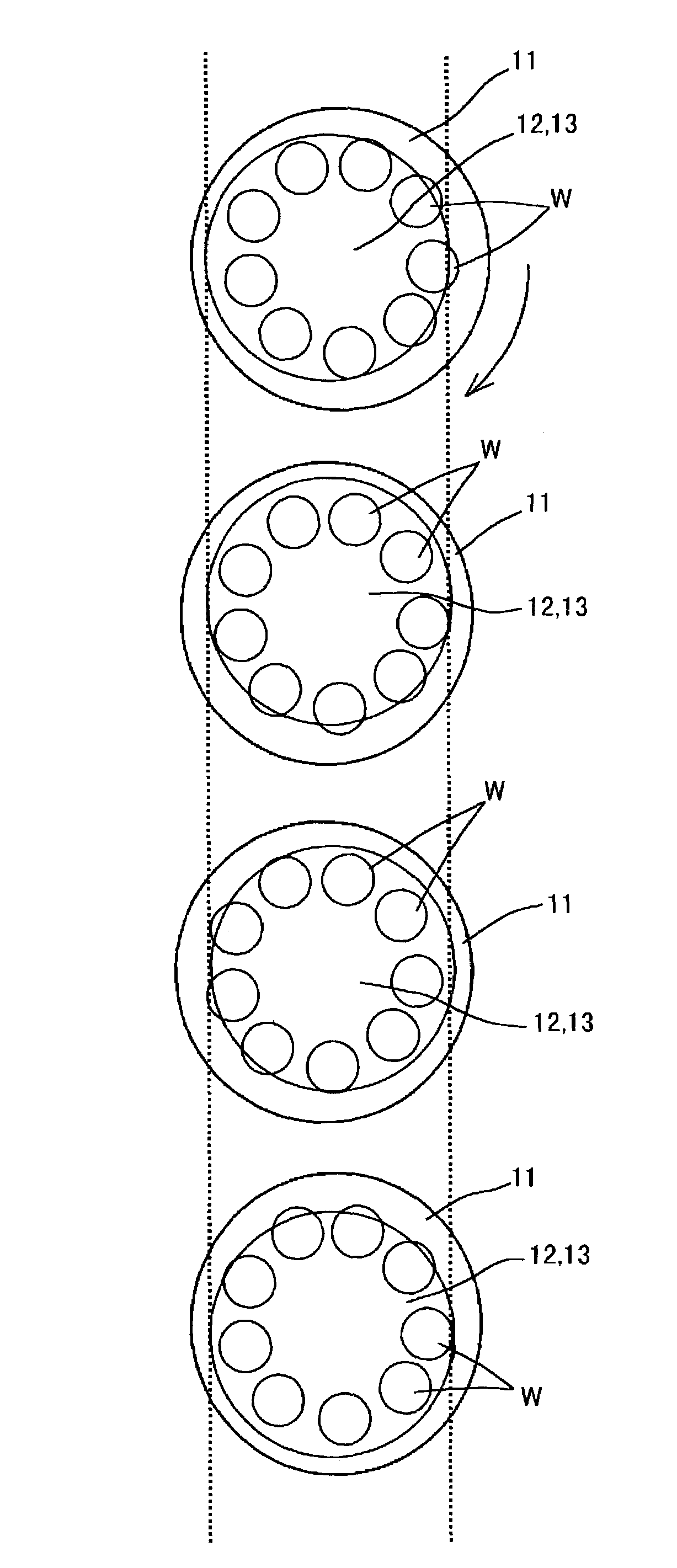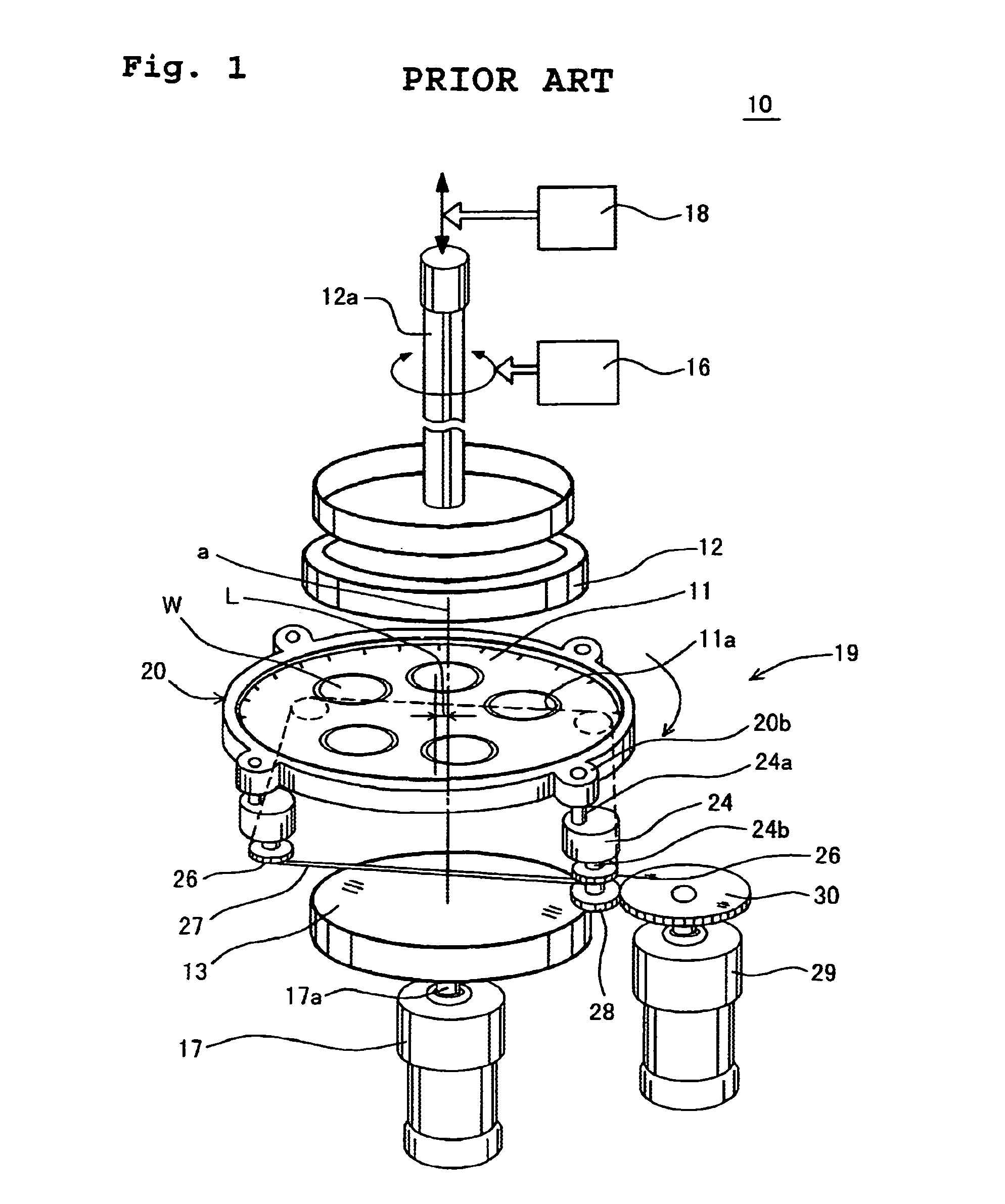Method of polishing semiconductor wafers by using double-sided polisher
a technology of semiconductor wafers and polishers, which is applied in the direction of grinding machines, manufacturing tools, lapping machines, etc., can solve the problems of unstable rotation as well as the speed of rotation of silicon wafers within the holding holes of corresponding wafers, and the deference between said frictional resistances is limited to a small amount, so as to prevent polishing sagging and increase the degree of flatness of semiconductor wafers
- Summary
- Abstract
- Description
- Claims
- Application Information
AI Technical Summary
Benefits of technology
Problems solved by technology
Method used
Image
Examples
first embodiment
[0073]In FIG. 1 and FIG. 2, reference numeral 10 generally designates a double-sided polisher to which is applied a method of polishing the semiconductor wafer according to the present invention (hereafter, simply referred to as a double-sided polisher). This double-sided polisher 10 comprises a carrier plate 11 made of epoxy-glass having a circular disc-like shape in plan view in which five of wafer holding holes 11a have been formed by every 72 degrees (in the circumferential direction) around an axis line of the plate so as to penetrate through the plate, and a pair of upper surface plate 12 and lower surface plate 13 functioning for clamping silicon wafers “W”, each having a diameter of 300 mm and having inserted and thus held operatively in the wafer holding hole 11a so as to be free to rotate therein, from above and below sides with respect to the wafers W and also functioning for polishing the surfaces of the wafers W by moving themselves relatively with respect to the silico...
second embodiment
[0100]Referring now to FIG. 9, a method of polishing semiconductor wafers by using a double-sided polisher according to the present invention will be described.
[0101]As shown in FIG. 9, this embodiment is representative of an example which has employed, instead of an upper surface plate 12 in the first embodiment, a surface plate 12A having a larger diameter than the lower surface plate 13.
[0102]This method also can create a difference between the frictional resistance acting on the front surface of the silicon wafer W from the upper surface plate 12A side and the frictional resistance acting on the back surface of the silicon wafer W from the lower surface plate 13 side in more positive manner as compared to the prior art. Consequently, the rotations of the silicon wafers W in respective wafer holding holes may be generated in a sure and steady manner.
[0103]Other description on configuration, operation and effect of this embodiment is almost same as in the first embodiment, which i...
third embodiment
[0104]Referring now to FIG. 10, a method of polishing semiconductor wafers by using a double-sided polisher according to the present invention will be described.
[0105]As shown in FIG. 10, this third embodiment is representative of an example which has employed, instead of the hard expanded urethane foam pad 14 having a circular shape in plan view extended over the upper surface plate 12 in the first embodiment, a hard expanded urethane foam pad 14A having a hexagonal shape in plan view.
[0106]In specific, since having a hexagonal shape, the polishing cloth 14 can create a difference in the frictional resistance in a positive manner with respect to the circular soft non-woven fabric pad on the lower surface plate 13. Consequently, during polishing of the wafers, the difference can be created more steadily as compared with the case of the prior art between the frictional resistance acting on the front surface of the wafer from the upper surface plate 12 side and the frictional resistan...
PUM
| Property | Measurement | Unit |
|---|---|---|
| size | aaaaa | aaaaa |
| diameter | aaaaa | aaaaa |
| diameter | aaaaa | aaaaa |
Abstract
Description
Claims
Application Information
 Login to View More
Login to View More - R&D
- Intellectual Property
- Life Sciences
- Materials
- Tech Scout
- Unparalleled Data Quality
- Higher Quality Content
- 60% Fewer Hallucinations
Browse by: Latest US Patents, China's latest patents, Technical Efficacy Thesaurus, Application Domain, Technology Topic, Popular Technical Reports.
© 2025 PatSnap. All rights reserved.Legal|Privacy policy|Modern Slavery Act Transparency Statement|Sitemap|About US| Contact US: help@patsnap.com



